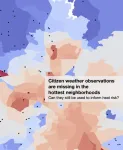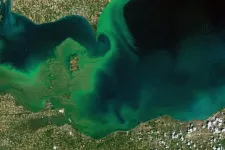(Press-News.org) (Santa Barbara, Calif.) — Computers have come so far in terms of their power and potential, rivaling and even eclipsing human brains in their ability to store and crunch data, make predictions and communicate. But there is one domain where human brains continue to dominate: energy efficiency.
“The most efficient computers are still approximately four orders of magnitude — that’s 10,000 times — higher in energy requirements compared to the human brain for specific tasks such as image processing and recognition, although they outperform the brain in tasks like mathematical calculations,” said UC Santa Barbara electrical and computer engineering Professor Kaustav Banerjee, a world expert in the realm of nanoelectronics. “Making computers more energy efficient is crucial because the worldwide energy consumption by on-chip electronics stands at #4 in the global rankings of nation-wise energy consumption, and it is increasing exponentially each year, fueled by applications such as artificial intelligence.” Additionally, he said, the problem of energy inefficient computing is particularly pressing in the context of global warming, “highlighting the urgent need to develop more energy-efficient computing technologies.”
Neuromorphic (NM) computing has emerged as a promising way to bridge the energy efficiency gap. By mimicking the structure and operations of the human brain, where processing occurs in parallel across an array of low power-consuming neurons, it may be possible to approach brain-like energy efficiency. In a paper published in the journal Nature Communications, Banerjee and co-workers Arnab Pal, Zichun Chai, Junkai Jiang and Wei Cao, in collaboration with researchers Vivek De and Mike Davies from Intel Labs propose such an ultra-energy efficient platform, using 2D transition metal dichalcogenide (TMD)-based tunnel-field-effect transistors (TFETs). Their platform, the researchers say, can bring the energy requirements to within two orders of magnitude (about 100 times) with respect to the human brain.
Leakage currents and subthreshold swing
The concept of neuromorphic computing has been around for decades, though the research around it has intensified only relatively recently. Advances in circuitry that enable smaller, denser arrays of transistors, and therefore more processing and functionality for less power consumption are just scratching the surface of what can be done to enable brain-inspired computing. Add to that an appetite generated by its many potential applications, such as AI and the Internet-of-Things, and it’s clear that expanding the options for a hardware platform for neuromorphic computing must be addressed in order to move forward.
Enter the team’s 2D tunnel-transistors. Emerging out of Banerjee’s longstanding research efforts to develop high-performance, low-power consumption transistors to meet the growing hunger for processing without a matching increase in power requirement, these atomically thin, nanoscale transistors are responsive at low voltages, and as the foundation of the researchers’ NM platform, can mimic the highly energy efficient operations of the human brain. In addition to lower off-state currents, the 2D TFETs also have a low subthreshold swing (SS), a parameter that describes how effectively a transistor can switch from off to on. According to Banerjee, a lower SS means a lower operating voltage, and faster and more efficient switching.
“Neuromorphic computing architectures are designed to operate with very sparse firing circuits,” said lead author Arnab Pal, “meaning they mimic how neurons in the brain fire only when necessary.” In contrast to the more conventional von Neumann architecture of today’s computers, in which data is processed sequentially, memory and processing components are separated and which continuously draw power throughout the entire operation, an event-driven system such as a NM computer fires up only when there is input to process, and memory and processing are distributed across an array of transistors. Companies like Intel and IBM have developed brain-inspired platforms, deploying billions of interconnected transistors and generating significant energy savings.
However, there’s still room for energy efficiency improvement, according to the researchers.
“In these systems, most of the energy is lost through leakage currents when the transistors are off, rather than during their active state,” Banerjee explained. A ubiquitous phenomenon in the world of electronics, leakage currents are small amounts of electricity that flow through a circuit even when it is in the off state (but still connected to power). According to the paper, current NM chips use traditional metal-oxide-semiconductor field-effect transistors (MOSFETs) which have a high on-state current, but also high off-state leakage. “Since the power efficiency of these chips is constrained by the off-state leakage, our approach — using tunneling transistors with much lower off-state current — can greatly improve power efficiency,” Banerjee said.
When integrated into a neuromorphic circuit, which emulates the firing and reset of neurons, the TFETs proved themselves more energy efficient than state-of-the-art MOSFETs, particularly the FinFETs (a MOSFET design that incorporates vertical “fins” as a way to provide better control of switching and leakage). TFETs are still in the experimental stage, however the performance and energy efficiency of neuromorphic circuits based on them makes them a promising candidate for the next generation of brain-inspired computing.
According to co-authors Vivek De (Intel Fellow) and Mike Davies (Director of Intel’s Neuromorphic Computing Lab), “Once realized, this platform can bring the energy consumption in chips to within two orders of magnitude with respect to the human brain — not accounting for the interface circuitry and memory storage elements. This represents a significant improvement from what is achievable today.”
Eventually, one can realize three-dimensional versions of these 2D-TFET based neuromorphic circuits to provide even closer emulation of the human brain, added Banerjee, widely recognized as one of the key visionaries behind 3D integrated circuits that are now witnessing wide scale commercial proliferation.
END
Researchers propose the next platform for brain-inspired computing
2024-06-26
ELSE PRESS RELEASES FROM THIS DATE:
Following the ‘BATT Signal:’ A new signaling pathway controlling planarian germ cells
2024-06-25
Biogenic monoamines — molecules like dopamine and serotonin — are famous for their role as the brain’s emissaries of mood, learning and memory, stress mechanisms, and fight-or-flight responses in the body.
But these neurotransmitters existed in nature long before brains popped up in the evolutionary tree. They’re prevalent in plants, bacteria, and single-cell organisms as well, but their functions there are far less understood.
Scientists at the Morgridge Institute for Research have added another task for ...
For many urban residents, it’s even hotter than their weather app says
2024-06-25
DURHAM, N.C. -- There’s a strong chance that last week’s scorching temperatures were even hotter than reported for those living in underserved urban areas.
It’s been well established that more impoverished areas within cities are typically hotter than their wealthier neighborhoods. Dubbed “urban heat islands,” these communities have more buildings, less vegetation and somewhat higher population density, which combine to produce the heating effect.
New research from environmental engineers at Duke University has shown that citizen science tools used to gauge heat in these ...
Bladder buzz: technologies to improve bladder surgery and monitoring
2024-06-25
A functional, healthy bladder is something that many of us take for granted. Yet millions of Americans deal with bladder issues, ranging from temporary inconveniences to long-lasting conditions. While many bladder disorders can be managed with non-invasive solutions, some conditions may require surgery to restore bladder function.
In patients with major bladder issues, a cystectomy may need to be performed. In this procedure, some or all of the bladder is removed (reasons for this may include acute trauma or bladder cancer). Sometimes, to compensate for the loss of tissue, the bladder is augmented (made larger), typically with ...
Half of world’s lakes are less resilient to disturbance than they used to be
2024-06-25
American Geophysical Union
Press Release 24-27
For Immediate Release
25 June 2024
This press release is available online at: https://news.agu.org/press-release/worlds-lakes-less-resilient-climate-pollution/
AGU press contact:
Rebecca Dzombak, news@agu.org (UTC-4 hours)
Contact information for the researchers:
Ke Zhang, Chinese Academy of Sciences, kzhang@niglas.ac.cn (UTC+8 hours)
WASHINGTON — Nearly half of the world’s large lakes have lost resilience, or the ability to bounce back after an abrupt disturbance, in recent ...
International trial introduces another curative option for sickle cell disease
2024-06-25
Vanderbilt University Medical Center (VUMC) researchers are touting data from a multicenter, international phase 2 clinical trial showing a new, curative treatment for sickle cell disease (SCD).
The therapy, nonmyeloablative haploidentical bone marrow transplant (BMT) with thiotepa and posttransplant cyclophosphamide (PTCy), is proving to have equivalent efficacy and one-fifth the cost as recently FDA-approved myeloablative gene therapy options, according to Michael DeBaun, MD, MPH, director of the Vanderbilt-Meharry Center ...
Study reveals potential therapeutic role of sodium valerate in reducing binge drinking
2024-06-25
In a significant finding, researchers from The Jackson Laboratory (JAX) and UConn Health have discovered that sodium valerate, a short-chain fatty acid produced by gut microbes, can dramatically reduce binge drinking behavior and blood ethanol concentration in mice. The study, reported June 17 in Microbiome, offers promising insights into the gut-brain axis and presents a novel therapeutic approach for excessive alcohol use.
We are interested in physiological addiction genetics and genomics to identify new drug targets for treating addiction/overdose.
The research team, led by Yanjiao Zhou, M.D., ...
Your future medications could be personalized for you on a 3D printer
2024-06-25
Chocolate-flavored pills for children who hate taking medicine.
Several drugs combined into one daily pill for seniors who have trouble remembering to take their medications.
Drugs printed at your local pharmacy at personalized dosages that best suit your health needs.
These are just a few potential advantages of 3D drug printing, a new system for manufacturing drugs and treatments on-site at pharmacies, health care facilities and other remote locations.
In 2015, the Food and Drug Administration approved the first 3D-printed drug, Spritam ...
Study finds foreign-born CEOs likelier to acquire international targets, including in their birth country
2024-06-25
Toronto - New research shows that CEOs who have moved away from their country of origin have a significantly higher tendency to make acquisitions internationally, with a preference for targets in their birth country or in countries that once colonized it.
“Foreign-born CEOs are taking an increasing leadership role in the corporate world,” says researcher Ron Shalev, an associate professor of accounting at the University of Toronto Scarborough who is cross-appointed to U of T’s Rotman School of Management. “In our sample, 24 per ...
For better loan terms, find a partner
2024-06-25
Shoppers browsing through blouses and blenders at Target know they can also quaff a cappuccino at one of more than 1,700 Starbucks cafeshoused within Targets. The strategic alliance benefits both corporations by helping them reach new markets, boost their brands, and add incremental sales.
Collaborative partnerships such as this have grown at a pace of 3,600 per year, according to the SDC Platinum database. That’s partly because companies in alliances can gain access to new technologies and customers while keeping their autonomy.
New research from Texas McCombs highlights ...
How uncertainty builds anxiety
2024-06-25
Alfred Hitchcock observed that “There is no terror in the bang, only in the anticipation of it.” A common way to build suspense in a movie scene is for the audience to know something bad is going to happen, but not when it is going to happen. But how does uncertainty work to ratchet up our anxiety? In a recent paper in the journal Computational Psychiatry, researchers at the University of California, Davis, Department of Psychology take a deeper look into what builds fear.
Not knowing when something will happen can cause anxiety, but until ...





